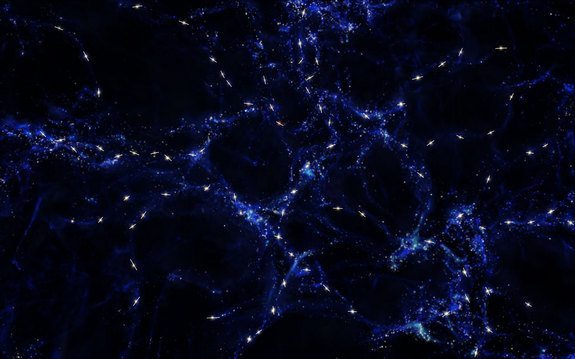Watch the video: “Quasar Alignment”
A spooky new image shows a web of bright galaxies aligned in the largest structures ever discovered in the universe.
Scientists working with a telescope in Chile discovered the alignment by studying 93 quasars — objects that shine very brightly and are powered by supermassive black holes — from the early universe. The picture (an artist’s impression created using data collected by the European Southern Observatory’s Very Large Telescope) shows the quasars aligned in a web of blue against the black sea of space.
Earlier studies have found that these quasars are “known to form huge groupings spread over billions of light-years,” European Southern Observatory (ESO) representatives said in a statement. The quasars studied by the research team formed when the universe was about 4.6 billion years old, about one-third of the age it is now, ESO added. [Biggest Structure in the Universe Explained (Infographic)]
“The first odd thing we noticed was that some of the quasars’ rotation axes were aligned with each other — despite the fact that these quasars are separated by billions of light-years,” study leader Damien Hutsemékers, from the University of Liège in Belgium, said in the same ESO statement.
Hutsemékers and his team also found that the quasars‘ rotation axes were linked to what is called the large-scale structure of the universe. Previous studies have shown that galaxies are not distributed evenly throughout the universe. Instead, the large star-filled objects clump together in a web, and this is the large-scale structure of the universe, according to ESO.
Scientists working with the Very Large Telescope found that the rotation of the quasars is parallel to the large-scale structures where the galaxies are found.
“The alignments in the new data, on scales even bigger than current predictions from simulations, may be a hint that there is a missing ingredient in our current models of the cosmos,” team member Dominique Sluse of the Argelander-Institut für Astronomie in Bonn, Germany and University of Liège, said.
Source and read more: Space.com
Best Regards
TBU NEWS



